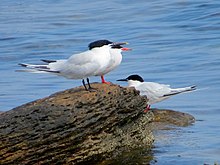
Back Sterretjies Afrikaans خرشناوات Arabic خرشناوات ARZ Sternidae AST Susüpürənlər Azerbaijani Žoviedra BAT-SMG Крачкавыя Byelorussian টার্ন Bengali/Bangla Sterninae Breton Estèrnids Catalan
| Terns Temporal range: Early Miocene to present
| |
|---|---|

| |
| A Sandwich tern, a common tern and a roseate tern together, Northumberland, UK | |
| Scientific classification | |
| Domain: | Eukaryota |
| Kingdom: | Animalia |
| Phylum: | Chordata |
| Class: | Aves |
| Order: | Charadriiformes |
| Family: | Laridae |
| Subfamily: | Sterninae Bonaparte, 1838 |
| Genera | |


Terns are seabirds in the family Laridae, subfamily Sterninae, that have a worldwide distribution and are normally found near the sea, rivers, or wetlands. Terns are treated in eleven genera in a subgroup of the family Laridae, which also includes several genera of gulls and the skimmers (Rynchops). They are slender, lightly built birds with long, forked tails, narrow wings, long bills, and relatively short legs. Most species are pale grey above and white below with a contrasting black cap to the head, but the marsh terns, the black-bellied tern, the Inca tern, and some noddies have dark body plumage for at least part of the year. The sexes are identical in appearance, but young birds are readily distinguishable from adults. Terns have a non-breeding plumage, which usually involves a white forehead and much-reduced black cap.
Terns are long-lived birds and are relatively free from natural predators and parasites; most species are declining in numbers due directly or indirectly to human activities, including habitat loss, pollution, disturbance, and predation by introduced mammals. The Chinese crested tern is critically endangered and three other species are classed as endangered. International agreements provide a measure of protection, but adults and eggs of some species are still used for food in the tropics.